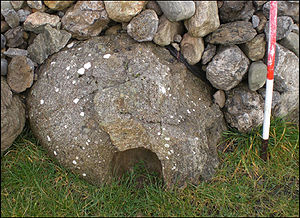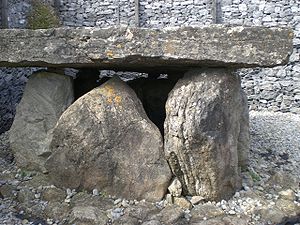
Listoghil
Encyclopedia
Listoghil is the large central monument in the Carrowmore
group of prehistoric tombs in County Sligo in Ireland
. It was numbered as Carrowmore 51 by George Petrie in 1837 and this designation is still used. According to Petrie (Letter to Larcom, Aug. 1837), the name may mean 'Ryefort' (it appears as Lios a tSeagail, seagail meaning rye
in Irish
, in early maps). Listoghil stands at the highest point in the Carrowmore complex, about 50m above sea level. It is surrounded (and generally, faced by) a cluster of 'dolmen circles'. Unlike these uncovered chambers, the central monument seems to have had a cairn or covering mound of stones. It is also much bigger than its satellites, being about 34m in diameter, the satellites average about 15m. Queen Maeve's tomb close by, on Knocknarea
Listoghil stands at the highest point in the Carrowmore complex, about 50m above sea level. It is surrounded (and generally, faced by) a cluster of 'dolmen circles'. Unlike these uncovered chambers, the central monument seems to have had a cairn or covering mound of stones. It is also much bigger than its satellites, being about 34m in diameter, the satellites average about 15m. Queen Maeve's tomb close by, on Knocknarea
, has a cairn twice the diameter, and stands at about 10 m.
Although the district of Knocknarea
, Cuil Irra, Cailleach a Vera, etc., is steeped in legend, Listoghil has never been satisfactorily connected with the ancient legends in the way that say, Newgrange
has. Writings by Charles Elcock from the 1880s describe workmen removing the stones for 'road metal' and perhaps building field walls. Only when quarrymen uncovered the tomb chamber in the middle of the mound did its destruction end. Antiquarians in the 19th century made references to another cairn nearby at Leacharail, but the site of this has never been located.


s of the period who recorded finding 'bones of horses', charred wood and a stone spearhead. Some materials from this tomb are in the Alnwick Castle
collection. In the late 1990s Goran Burenhult, the Swedish archaeologist, partly excavated Listoghil. He dated bone and carbon material, and exposed the still-intact kerb
. In the late 1990s the tomb was restored by the Office of Public Works
. The tomb now consists of a 4 m tall, 34 m diameter cairn
. Access to the central chamber - via a 13 m artificial avenue of gabions - is possible. The chamber at the heart of the mound is a dolmen-like structure, with 6 orthostat
s. A single limestone slab - tilted at a slight angle - crowns the chamber. A rare example of Irish megalithic art
outside of the Boyne valley
, consisting of concentric circular carvings, can be seen on the front side of the roof slab (this is visible only in certain lighting conditions). A symbol described by Julian Cope
as 'a strangely distorted tryfuss' has been carved on a stone inside.
Bone and carbon material from Listoghil was carbon dated to between 3640 and 3380 BC. The human bones found there were a mixture of cremated, and un-cremated bones; the older, smaller tombs around it generally contain burnt bones. Evidence of some earlier activity on the site - carbon material calibrated to around 6100 years ago - was found by the Swedish archaeologist who excavated Listoghil. This was discovered in the context of an area of 'massive stone packing', set on the earthen platform on which Listoghil is constructed, outside the kerb, to the south of the tomb. Extensive burning took place on the area of the site before the tomb was erected.
Carrowmore
Carrowmore, County Sligo is one of the four major passage tomb cemeteries in Ireland. It is located at the centre of a prehistoric ritual landscape on the Cúil Irra Peninsula in County Sligo in Ireland....
group of prehistoric tombs in County Sligo in Ireland
Republic of Ireland
Ireland , described as the Republic of Ireland , is a sovereign state in Europe occupying approximately five-sixths of the island of the same name. Its capital is Dublin. Ireland, which had a population of 4.58 million in 2011, is a constitutional republic governed as a parliamentary democracy,...
. It was numbered as Carrowmore 51 by George Petrie in 1837 and this designation is still used. According to Petrie (Letter to Larcom, Aug. 1837), the name may mean 'Ryefort' (it appears as Lios a tSeagail, seagail meaning rye
Rye
Rye is a grass grown extensively as a grain and as a forage crop. It is a member of the wheat tribe and is closely related to barley and wheat. Rye grain is used for flour, rye bread, rye beer, some whiskeys, some vodkas, and animal fodder...
in Irish
Irish language
Irish , also known as Irish Gaelic, is a Goidelic language of the Indo-European language family, originating in Ireland and historically spoken by the Irish people. Irish is now spoken as a first language by a minority of Irish people, as well as being a second language of a larger proportion of...
, in early maps).

Knocknarea
Knocknarea is a large hill west of Sligo town in County Sligo, Republic of Ireland.The high limestone hill is visually striking, as it is monolithic in appearance and stands in a prominent position on the Cúil Irra peninsula between the bays of Sligo and Ballysadare. At the summit is a large...
, has a cairn twice the diameter, and stands at about 10 m.
Although the district of Knocknarea
Knocknarea
Knocknarea is a large hill west of Sligo town in County Sligo, Republic of Ireland.The high limestone hill is visually striking, as it is monolithic in appearance and stands in a prominent position on the Cúil Irra peninsula between the bays of Sligo and Ballysadare. At the summit is a large...
, Cuil Irra, Cailleach a Vera, etc., is steeped in legend, Listoghil has never been satisfactorily connected with the ancient legends in the way that say, Newgrange
Newgrange
Newgrange is a prehistoric monument located in County Meath, on the eastern side of Ireland, about one kilometre north of the River Boyne. It was built around 3200 BC , during the Neolithic period...
has. Writings by Charles Elcock from the 1880s describe workmen removing the stones for 'road metal' and perhaps building field walls. Only when quarrymen uncovered the tomb chamber in the middle of the mound did its destruction end. Antiquarians in the 19th century made references to another cairn nearby at Leacharail, but the site of this has never been located.


Excavation and Restoration
By the end of the 19th century the tomb had been investigated by antiquarianAntiquarian
An antiquarian or antiquary is an aficionado or student of antiquities or things of the past. More specifically, the term is used for those who study history with particular attention to ancient objects of art or science, archaeological and historic sites, or historic archives and manuscripts...
s of the period who recorded finding 'bones of horses', charred wood and a stone spearhead. Some materials from this tomb are in the Alnwick Castle
Alnwick Castle
Alnwick Castle is a castle and stately home in the town of the same name in the English county of Northumberland. It is the residence of the Duke of Northumberland, built following the Norman conquest, and renovated and remodelled a number of times. It is a Grade I listed building.-History:Alnwick...
collection. In the late 1990s Goran Burenhult, the Swedish archaeologist, partly excavated Listoghil. He dated bone and carbon material, and exposed the still-intact kerb
Megalithic architectural elements
This article describes several characteristic architectural elements typical of European megalithic structures.-Forecourt:In archaeology, a forecourt is the name given to the area in front of certain types of chamber tomb...
. In the late 1990s the tomb was restored by the Office of Public Works
Office of Public Works
The Office of Public Works is a State Agency of the Department of Finance in the Republic of Ireland...
. The tomb now consists of a 4 m tall, 34 m diameter cairn
Cairn
Cairn is a term used mainly in the English-speaking world for a man-made pile of stones. It comes from the or . Cairns are found all over the world in uplands, on moorland, on mountaintops, near waterways and on sea cliffs, and also in barren desert and tundra areas...
. Access to the central chamber - via a 13 m artificial avenue of gabions - is possible. The chamber at the heart of the mound is a dolmen-like structure, with 6 orthostat
Megalithic architectural elements
This article describes several characteristic architectural elements typical of European megalithic structures.-Forecourt:In archaeology, a forecourt is the name given to the area in front of certain types of chamber tomb...
s. A single limestone slab - tilted at a slight angle - crowns the chamber. A rare example of Irish megalithic art
Megalithic art
Megalithic art refers to the use of large stones as an artistic medium. Although some modern artists and sculptors make use of large stones in their work, the term is more generally used to describe art carved onto megaliths in prehistoric Europe....
outside of the Boyne valley
River Boyne
The River Boyne is a river in Leinster, Ireland, the course of which is about long. It rises at Trinity Well, Newbury Hall, near Carbury, County Kildare, and flows towards the Northeast through County Meath to reach the Irish Sea between Mornington, County Meath and Baltray, County Louth. Salmon...
, consisting of concentric circular carvings, can be seen on the front side of the roof slab (this is visible only in certain lighting conditions). A symbol described by Julian Cope
Julian Cope
Julian Cope is a British rock musician, author, antiquary, musicologist, poet and cultural commentator...
as 'a strangely distorted tryfuss' has been carved on a stone inside.
Bone and carbon material from Listoghil was carbon dated to between 3640 and 3380 BC. The human bones found there were a mixture of cremated, and un-cremated bones; the older, smaller tombs around it generally contain burnt bones. Evidence of some earlier activity on the site - carbon material calibrated to around 6100 years ago - was found by the Swedish archaeologist who excavated Listoghil. This was discovered in the context of an area of 'massive stone packing', set on the earthen platform on which Listoghil is constructed, outside the kerb, to the south of the tomb. Extensive burning took place on the area of the site before the tomb was erected.
Sources
- Tombs for Hunters, Burenhult, G, British Archaeology 82, 2005, pp22–27
- The Megalithic European, Cope, JJulian CopeJulian Cope is a British rock musician, author, antiquary, musicologist, poet and cultural commentator...
, Harper Collins, London, 2004 - Letter from Petrie to Larcom, Aug 12 1837. Ordnance Survey Letters, Royal Irish Academy, Shelf Mark 14 F 14 No 45

